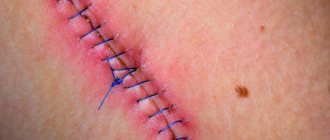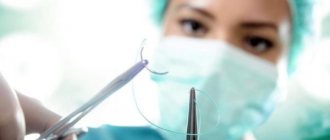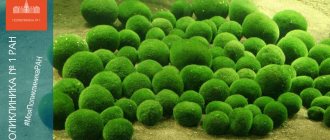Skin glue or threads: how to get the most invisible suture after surgery?
The process of wound healing in plastic surgery is one of the most important stages towards obtaining an aesthetically attractive result. If for general surgery the most important requirement for suture material is to ensure better healing, then for aesthetic surgery, in addition to this, there is also a requirement to minimize the consequences of postoperative wounds, that is, the desire for a complete absence of scars.
Modern suture materials include absorbable and non-absorbable sutures based on synthetic materials such as polydiaxonone, polyglycolic acid, polyglycolic acid, polyglycolic acid, glycolide copolymer, epsilon-caprolactone and others. Natural materials (catgut) are also used, which are made from the tissues of large and small livestock. This suture material is used mainly only when suturing internal organs, mucous membranes, muscles and tendons, and last but not least for suturing external wounds. Because catgut consists almost entirely of connective tissue, it can contribute to the formation of unattractive, large scars.
There is a third type of suture material, which, although relatively new in comparison with threads, is nevertheless widely used today in the work of plastic surgeons in Russia and abroad. We are talking about cyanoacrylate adhesives. Initially, these adhesives were to be used as an alternative to threads for surgery of internal organs and mucous membranes. However, studies have shown that the glue reacts with body fluids and, when disintegrating, turns out to be toxic. At the same time, the glue showed itself in the best and safest way when stitching external postoperative wounds.
Plastic surgery patients are well aware of the troubles they face in the first few days after surgery. In addition to the restriction of movements or the need to sleep only in a certain position, which most patients can easily endure, there are many other unpleasant moments that cause much more significant discomfort - not taking a shower, changing bandages at certain intervals, and finally, removing stitches, which causes many people considerable stress.
Taking this into account, Russian and foreign scientists have conducted a number of studies on how the rehabilitation process proceeds when stitching wounds in the traditional way - with staples or threads and when applying glue, and most importantly, how the final cosmetic effect will differ. Differences also appeared at the stage of the operation, when closing wounds, since working with glue turned out to be less energy-intensive and took less time than suturing, which ultimately did not require additional anesthesia.
It is worth noting that when working with skin glue, traditional suture material is still applied to the skin, but only to stitch the edges of the wound; the glue itself is applied to the main part of it. The whole process doesn't take even five minutes. The first layer of glue dries, after which the doctor applies a second one. For the applied substance to completely harden, you need to wait about 2-3 minutes.
When the wound is closed in the traditional way, that is, with the help of threads, the doctor first applies a suture and then applies special strip stickers that provide better skin tension.
The biggest advantage of glue from the point of view of the patients themselves is that they have relative freedom - for example, they can take a shower without fear of getting the suture area wet, which is impossible when stitching a wound with threads - they cannot take a shower, since the wound area must remain as dry as possible .
In addition to the above, according to research by specialists, patients usually do not show any skin reactions to the glue. The exception is allergic reactions, however, this is specified and determined in advance. However, some patients have a skin reaction to strip stickers.
The most important advantage of the glue, according to surgeons, is that the bacteriological protection of the glue is 95%, and it remains so for 72 hours after surgery - the most dangerous time in terms of wound infection. Then it starts to decline. In addition, the glue does not involve applying any gels or ointments to the wound, which is necessary when stitching the wound with threads.
As for the main criterion - the aesthetic result. So far, the opinions of scientists do not provide an objective and unambiguous answer. Their research shows approximately the same results using both glue and creating traditional seams. Scars 12 or more months after surgery remain similar, provided the initial ones are the same. True, some experts draw conclusions in favor of glue, noting that after a long period after surgery, scars healed with its help look better than those that were traditionally sewn up with threads.
One way or another, it can be stated with certainty that the use of cyanoacrylate glue for closing wounds has significantly improved the postoperative rehabilitation period for patients and made it more comfortable.
You can learn more about plastic surgery in the “Body plastic surgery” section.
Caring for cosmetic sutures in the postoperative period
Caring for a cosmetic suture in the postoperative period does not differ from that when applying a conventional surgical suture. An important condition for successful healing is compliance with the rules of asepsis and antisepsis, as well as careful treatment of the wound. The bioabsorbable suture material used for this type of suture dissolves itself, which reduces the risk of infection when removing the thread. Also, in the early stages of healing, anti-inflammatory ointments may be recommended, and in a later period, agents that reduce scar formation.
Share:
Why do keloid scars appear?
Keloid scars are a complication of breast augmentation. Among the reasons for their formation are the following:
- features of the body's immune system,
- hereditary predisposition,
- excessive skin tension in the healing zone,
- suppuration or infection of a postoperative wound.
It should be noted that sutures after mammoplasty rarely turn into keloids. This process mainly has a hereditary predisposition and manifests itself gradually, in some cases up to 2 years. Therefore, with constant monitoring by a doctor, you can notice changes occurring in time and stop their development.
How to properly care for seams
If the patient is in the hospital, a doctor or nurse will care for the sutures. At home, the patient should follow the doctor's recommendations for wound care. It is necessary to keep the wound clean, treat it daily with an antiseptic: a solution of iodine, potassium permanganate, brilliant green. If a bandage is applied, consult your doctor before removing it. Special medications can speed up healing. One of these products is contractubex gel, containing onion extract, allantoin, and heparin. It can be applied after epithelization of the wound.
Healing of sutures after childbirth
For the speedy healing of postpartum sutures, strict adherence to hygiene rules is required:
All comments
Elena 11/27/2017 at 11:47 am # Reply
Thank you very much for the article! I especially liked the part about the factors that affect the speed of healing of sutures
Seam gluing during breast augmentation
Today, plastic surgery is developing exponentially. And the main goal of a plastic surgeon is to make scars as invisible as possible. Specialists use innovative technology of “seam gluing”. Its essence lies in the use of special medical glue for the skin. By the way, the seam gluing technique is often called the “seamless method of breast augmentation.” How does this happen?
In the operating room, the plastic surgeon applies a cosmetic suture to the wound using absorbable suture. This is an important point! Do not believe if they tell you that the edges of the wound will only be glued together with glue. There are always stitches! This is usually an absorbable thread, so the stitches are not removed after breast augmentation.
Only a stitched wound can be sealed by a plastic surgeon with glue. It is applied to the seam. In fact, medical glue acts as a kind of “plaster” that protects the wound and suture.
Advantages of seam gluing after mammoplasty:
- maximum protection of the seam from the external environment, bacteria and weathering;
- the seams do not require care;
- obtaining a high aesthetic result.
The scar after breast augmentation, made using the “suture gluing” technique, looks the same after 1 month as it did after 6-8 months. By the way, seam gluing is used for a tummy tuck (abdominoplasty).
How to reduce a scar after mammoplasty?
If you still have scars after breast surgery that are not aesthetically pleasing to you, then you can resort to reducing them. Often girls turn to cosmetologists who offer procedures that can reduce the appearance of scars. These are peelings, microdermabrasion and laser resurfacing. Today, patients are most often offered laser scar resurfacing - this is the most reliable method of eliminating them. For example, you can do resurfacing using the latest generation Fotona laser.
Suture materials for cosmetic seams
Requirements for surgical sutures were formed during the entire process of development of the surgical business. Initially, they had to be simply durable in order to eliminate the risk of wound divergence and infection. Then they began to attach importance to appearance, especially on visible parts of the body (face, neck). Gradually, not only various types of surgical sutures began to appear, but also suture materials, as well as needles, on which the visibility of the future scar also depends.
By the way! A cosmetic suture differs from a regular surgical suture precisely in its appearance. It is almost invisible and is a very thin line that follows the natural contours (sometimes it resembles a wrinkle or fold, for example, on the neck or lower abdomen).
Self-absorbable threads that do not require removal have become especially popular today. They are organic in nature, so over time after suturing they simply disappear under the influence of biological fluids (blood, lymph) and enzymes, in particular proteins. Such threads are often used in dentistry so that the doctor, when removing sutures, does not once again disturb the delicate gum tissue.
Cosmetic self-absorbable sutures are often placed using a suture material called MedPGA. The last three letters mean that the threads are made based on polyhydroxyacetylic acid.
Initially, this thread is very strong and allows you to firmly sew the edges of the skin. On the 20th day, approximately 50% of its strength remains, but this is enough to hold an already healed wound. MedPGA is completely absorbed in 60-90 days.
There are also three more types of self-absorbing surgical sutures used for cosmetic sutures.
- Catgut. Resorption time ranges from 1 to 4 months depending on the diameter of the thread and the operated area.
- Lavsan. Dissolves faster than catgut: from 12 to 50 days.
- Vicryl. Analogue of catgut. The vicryl suture dissolves, on average, in 70-80 days.
Sutures after caesarean section
If after a cesarean section there was no scar left on the abdomen, then, probably, more women would prefer this method of delivery. After all, many are frightened not by the fact of abdominal surgery itself (and in fact that is what it is), but by the presence of an ugly scar on the abdomen. In addition, very young girls who do not want to lose their attractiveness because of a huge scar often become mothers.
A cosmetic suture after a cesarean section will not be particularly noticeable if a planned operation was performed with a transverse incision in the pubic area. Due to the anatomical features, the sutures will be placed continuously and they will heal quickly. The remaining thin scar will run along the lower fold of the abdomen, i.e. along the line of underwear.
By the way! If the incision site hurts after a cesarean section, you should consult a doctor. You must first find out the exact cause of the pain (infection, spasm, hernia caused by surgery), and not take painkillers without prescription, as mothers often do.
During an emergency caesarean section, doctors are sometimes forced to make a vertical incision from the navel to the pubic area. The scar will be noticeable for two reasons. Firstly, because of the location, and secondly, because of the characteristics of the stitching technology. The resulting nodules will subsequently become denser, and the scar will be not only wide, but also convex. Suture plastic surgery after a caesarean section will help eliminate such a defect.











